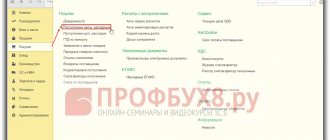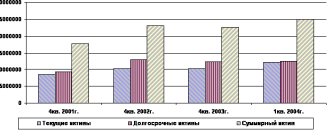The act of acceptance and transfer of property into the authorized capital, a sample and form of which are available for download below, is an important part of the document flow of the organization in which one of the founders chose to contribute in the form of material resources.
- Form and sample
- Free download
- Online viewing
- Expert tested
FILES
Within the framework of the company’s relationship with its owners, the act of acceptance and transfer of property into the authorized capital is of paramount importance. All subsequent tax inspections will most likely begin with his demand.
The authorized capital is the fund formed when an organization is created. This is what the LLC risks when it conducts its activities. The smallest size of this fund for a PJSC will be 100 thousand rubles, for other forms of organization - 10 thousand rubles.
It is interesting that, according to existing legislation, if a decision is made to create an individual entrepreneur, then the entrepreneur risks all the property owned by him at once. And if he decides to become the founder of an LLC, then in case of bankruptcy it will be possible to recover from him only the authorized capital directly, the amount of which is 10 thousand rubles.
What is meant by a contribution to the authorized capital and in what form is it paid for?
If you decide to create a business company, you will need knowledge of civil, accounting and tax legislation.
We will talk about its individual important norms in our article. The contribution to the authorized capital (VUC) refers to the following made by the founders or participants of a business company:
- money;
- non-monetary assets (shares of other business entities, intellectual rights, things, etc.)
Find out in what order the authorized capital of an LLC is paid in the Typical Situation from ConsultantPlus. Get free demo access to K+ and go to the material to find out all the details of this procedure.
VUK allows:
- ensure the activities of the company at the initial stage after creation or support its financial capabilities during operation (with an increase in the authorized capital);
- determine the amount of debt the company owes to each founder, received by him after leaving the ownership group (the actual value of the share);
- ensure the interests of the company's creditors;
- assess the necessary conditions for interaction between the company and the founders (determining the degree of participation of the founder in making management decisions based on the size of the VUC, establishing the procedure for distributing profits, etc.).
Payment of the authorized capital depends on the type of VUC:
- cash VUK are transferred to the company's current account or deposited in its cash desk.
- property VUCs are transferred to society according to a special algorithm (we will talk about this later).
Find out how a nominal share in the authorized capital differs from a real one from the article “Why is the authorized capital of an LLC needed and can it be spent?”
Selection of an independent appraiser
Art. 3 of Law No. 135-FZ, appraisal means professional activity to establish the market, cadastral and other value of objects. The property contributed to the authorized capital of an LLC can be appraised by a specialized company or a private appraiser registered with the relevant self-regulatory organization (SRO). A list of all current SRO appraisers is provided on the Rosreestr website. Before contacting an appraiser, it is recommended to request title documents and a liability insurance agreement.
When it comes to choosing appraisal companies, they often focus on prices. The cost of services varies depending on the region, the reputation of the company, and the type of property: from 1,000 rubles for a laptop to 50,000 or more for securities. The speed of reporting and the willingness to carry out the procedure remotely may be important for owners. The activities of appraisers are not limited geographically, so you can use the services of a company from any region of the Russian Federation.
In Art. 16 Federal Law No. 135 establishes restrictions on the choice of appraisers from the point of view of conflict of interest. A private appraiser or company should not be involved in any way with the customer and his property:
- not be related;
- not to be business partners and not to have an employer-employee relationship;
- not be a creditor or debtor of the client;
- have no rights or property interests in relation to the objects of assessment.
The appraiser is responsible for overestimating the value of the non-monetary contribution transferred by the founder to the LLC. If, within a three-year period from the date of payment/increase in the authorized capital at the expense of the valued property, the participants have subsidiary liability for the obligations of the company, the appraiser is also involved jointly and severally within the limits of the allowed overstatement.
Losses caused by the appraiser are compensated by:
- property of the appraiser-individual;
- funds from the appraisal company;
- compensation under a liability insurance contract within the limits of the insured amount;
- SRO compensation fund up to 5 million rubles per insured event.
Stages of contributing property to the authorized capital
The procedure for entering VUK with property includes several stages:
- stage 1 - description in the constituent documents of the company of the possibility of entering the VUK with property and the procedure for carrying out this procedure;
- stage 2 - confirmation by the founder of the rights to the transferred property VUC;
- stage 3 - independent assessment of the transferred property;
- stage 4 - approval of the results of the assessment of the VUK by the founders (drawing up minutes of the general meeting of owners or other similar document);
- stage 5 - registration of the fact of transfer of property as a VUK (signing of the transfer and acceptance certificate);
- stage 6 - implementation of VUK accounting procedures in the tax and accounting system;
- stage 7 - the founders and the appraiser bear subsidiary liability for the unreliable amount of the property valuation.
In the following sections we will dwell in more detail on the individual features of this procedure.
What norm of the Civil Code of the Russian Federation should be taken into account in the procedure for a company to receive contributions to the authorized capital with property?
If you are establishing a business company, when forming the authorized capital, you must take into account the requirements of Art. 66.2 of the Civil Code of the Russian Federation - clause 2 of this article contains a rule on the mandatory payment in money of the minimum amount of the authorized capital.
Property contributions are permissible only in the remaining part of the authorized capital if it exceeds the minimum amount permitted by law.
Let's explain with an example:
In the constituent agreement of TSK Plus LLC, the size of the authorized capital is indicated as 100,000 rubles.
The founder of the company intended to contribute equipment as a VUK. Taking into account the norms of the Civil Code of the Russian Federation and the Law “On Limited Liability Companies” dated 02/08/1998 No. 14-FZ (hereinafter referred to as the LLC Law), he calculated the monetary and non-monetary components of the authorized capital:
VUK = DV + NDV,
100 000 = 10 000 + 90 000,
Where:
DV—minimum authorized capital for an LLC (Clause 1, Article 14 of the LLC Law);
NDV - the amount of the authorized capital minus the above minimum amount.
The founder formed the authorized capital in the following order:
- 10,000 rub. — transferred to the bank account of TSK Plus LLC;
- 90,000 rub. - transferred equipment to the company for this amount (after receiving an independent assessment of the value of this property and approval of the assessment results).
ConsultantPlus experts explained how to determine and approve the value of property contributed to the authorized capital of an LLC. If you do not have access to the K+ system, get a trial online access for free.
It is also necessary to pay special attention to the content of such a constituent document as the protocol (or decision) on the creation of the company.
As judicial practice shows (for example, the decision of the Arbitration Court of the Sverdlovsk Region dated 08/02/2016 in case No. A60-12861/2016), the absence in the decision to create a company of a description of the conditions for the formation of the authorized capital can lead to refusal of state registration of the company.
According to tax authorities and judges, such mandatory information includes the following information:
- on the size and nominal value of the founder’s share;
- the procedure and timing of payment of the authorized capital.
In such a situation, it will no longer matter in what form the VUC is contributed (property or money) - the possibility of the existence of society itself will be in question.
Points of agreement
Since the act is a kind of agreement between a private individual and a legal organization (the first transfers its property to the second), the text reflects a number of fundamentally important points regarding the nature of the interaction, namely:
- The name of the property and its market value (it is written in numbers and words). The first paragraph may also contain a document confirming these figures. In the example, this is a report on determining the market value, but it can also be a check.
- The second paragraph of the act serves to emphasize the purpose for which a person transfers property to a legal entity - in payment for a share of the authorized capital. This mention is necessary because a person can simply donate property, give it as a gift, transfer it for the purpose of sale, etc.
- Confirmation that the transferred property is the property of the transferor and is not the property of any other person. It is also a mandatory requirement that, for example, the car being transferred was not pledged, is not subject to confiscation, etc.
- How many copies is the paper prepared in (minimum number - two). At the end, there must be signatures of representatives of both parties, both those receiving and transferring the property.
“Accounting” stage for property contribution
Property VUK reflect:
- in accounting - at the cost agreed by the founders (using posting Dt 75 “Settlements with founders” Kt 80 “Authorized capital”);
- in tax accounting - according to the tax accounting data of the transferring party.
A variety of property (fixed assets, inventories, goods, etc.) can act as a property asset, therefore, it is necessary to apply the appropriate accounting and tax accounting standards to the accounting of each individual type of property asset asset.
Let us consider, using an example, the features of the transfer by the founder and the receipt by the company in the form of a VUK of property that meets the criteria of a fixed asset:
LLC "X" received a used lathe from PJSC "U" as a VUK.
Initial data:
- the initial and residual cost of the machine, according to the transferring party, is 2.5 million rubles. and 1.8 million rubles. respectively;
- the size of the VUK according to the act of an independent appraiser and constituent documents - 2 million rubles;
- There are no additional expenses for the transfer of the machine as a VUK.
The following entries will be made in the accounting of the transferring party (PJSC “U”):
| Account correspondence | Amount, rub. | Content | |
| Debit | Credit | ||
| 58 | 76 | 2 000 000 | Reflection of debt on payment of authorized capital |
| 01 | 01 | 2 500 000 | Write-off of the initial cost of fixed assets transferred as VUK |
| 02 | 01 | 700 000 (2 500 000 – 1 800 000) | Write-off of accrued depreciation of a lathe |
| 76 | 01 | 1 800 000 | Write-off of the residual value of the machine |
| 19 | 68 | 324 000 (1 800 000 × 18%) | Recovering VAT from the residual value of the machine |
| 91 | 19 | 324 000 | Recovered VAT included in other expenses |
In the accounting of the receiving party (LLC “X”):
- debt to PJSC “U” under VUK: Dt 75 Kt 80 in the amount of 2 million rubles. (the value of the property VUK confirmed by an independent appraiser and approved by the founders).
- the cost of the machine received as a VUK is reflected by the posting: Dt 08 Kt 75 in the amount of 2 million rubles. (after putting the machine into operation: Dt 01 Kt 08).
How to show the authorized capital in the reporting, says the material “In which section is the authorized capital reflected in the balance sheet?”
Submitting documents to the tax office
A set of documents for registering an increase in the authorized capital must be submitted to the Federal Tax Service no later than a month from the date of the decision to approve the results of making additional contributions.
You can choose the method of submitting documents that is convenient for you:
- Personal submission
by the applicant indicated on sheet M, or his representative by notarized power of attorney to the Federal Tax Service or MFC. - Sending by
registered mail. It is necessary to indicate the declared value and make an inventory of the investment. In Moscow you can use courier services. - Electronic transmission
of information through the tax office’s online service if you have an electronic signature.
If everything is in order with the documents, changes will be registered within 5 working days.
Tax subtleties of accounting for property contributions
Income tax
In tax accounting, property received in the form of VUK that meets the criteria of a fixed asset (FA):
- is not recognized as income of the company (subparagraph 3, paragraph 1, article 251, subparagraph 1, paragraph 1, article 277 of the Tax Code of the Russian Federation);
- is accounted for at historical cost (OSC), calculated using the formula:
PSOS = OSPS + DRPS,
Where:
OSPS - residual value of fixed assets according to the tax accounting data of the transferor;
DRPS - additional expenses of the transferring party associated with the transfer of property to the VUK (if these expenses are defined as the VUK - subclause 2, clause 1, article 277 of the Tax Code of the Russian Federation).
If the receiving party does not have documentary evidence of the value of the property VUC in tax accounting, it is recognized as zero (subclause 2, clause 1, article 277 of the Tax Code of the Russian Federation).
Property tax
Property received by the company as a capital asset, accounted for on its balance sheet as a fixed asset, is subject to property tax:
- based on the cadastral value - if the property transferred as a VUK is included in the list of objects for which the tax base is determined as their cadastral value (regardless of the estimated value of the transferred property);
- average annual value according to accounting data - if the property received is not included in the specified list.
Find out about the tax rate for “cadastral” real estate from the article “Step-by-step instructions for calculating property tax from the cadastral value.”
Is property included in the Criminal Code recognized as fixed assets?
The accounting regulations PBU No. 6/01 “Accounting for fixed assets” (Order of the Ministry of Finance of the Russian Federation No. 26n dated March 30, 2001) does not make a difference between assets included in the Criminal Code, acquired for a fee and received for other reasons by the enterprise.
The most important thing in recognizing an asset as a fixed asset is its simultaneous compliance with all the requirements specified in clause 4 of PBU No. 6/01:
- the object is used in the manufacture of products, when performing work, providing services, or for management purposes of the company, or is intended to be provided for temporary possession and use or use for a fee;
- the asset is intended for operation for a period of more than 12 months;
- its subsequent resale is not intended;
- and the asset itself is capable of generating income for the organization in the future.
If the property included in the Criminal Code meets all the above requirements, then it is recognized as a fixed asset.
At the same time, the enterprise is assigned the right to assets that meet the criteria of clause 4 of PBU No. 6/01, but do not exceed the value of 40 thousand rubles per unit :
- taken into account as part of fixed assets and accrue depreciation on them (if its accrual is provided for by PBU No. 6/01), i.e. take them into account in account 01 “Fixed assets” or in account 03 “Income-generating investments in tangible assets” (if intended for transfer for temporary use and possession or use for a fee);
- be taken into account as part of inventories (hereinafter referred to as inventories), i.e. on account 10 “Materials” and on an independent sub-account, for example, “Low-valued fixed assets”.
The decision made must be approved in the accounting policy of the enterprise.
In addition, it is not necessary to apply a cost restriction to all low-value fixed assets. The Accounting Policy may provide an additional criterion for classifying property as low-value. For example, assets worth up to 40 thousand rubles are written off as inventory if they quickly lose their consumer qualities, etc.
It is worth noting that the above options for the procedure for accounting for fixed assets are associated only with the choice of the procedure for writing off their value - at a time as part of the inventory or through depreciation over a certain period of use, but not less than 13 months (!). In both cases, assets are recognized as fixed assets.
But in the event of their one-time write-off as part of the inventory, it will be necessary to organize control over the subsequent movement of such assets. Since only their cost is written off, and they themselves do not leave the enterprise. For this purpose you can choose:
- for example, the Inventory Book of the OS-6b form, which was approved by the State Statistics Committee of the Russian Federation in its Resolution No. 7 of January 21, 2003;
- or develop this document yourself, guided by the provisions of Federal Law No. 402-FZ of 06.12.11. “On Accounting”, its Article 10, which sets out the requirements for accounting registers.
In fact, such assets - written off as part of inventories - will be taken into account off-balance sheet after their value is written off.
How long should they be kept under such control? PBU No. 6/01 does not speak directly about this. But it indirectly confirms that during their useful life, but not less than 13 months (clause 4, clause 5 of PBU No. 6/01).
For this purpose, an enterprise can “open” an additional off-balance sheet account, for example 012 “Low-valued fixed assets”. But to use this account, its opening must be agreed upon with the Ministry of Finance of the Russian Federation (Instructions for the Chart of Accounts, approved by order of the Ministry of Finance of the Russian Federation No. 94n dated October 31, 2000).
But the question is, at what cost should such assets be taken into account and written off in accounting?
Results
Contribution of the authorized capital with property occurs in several stages - the founders provide for this possibility in the constituent documents, organize an independent assessment of the property contribution, approve its results, etc. Contribution to the authorized capital with property is possible only after payment in money of the minimum amount established by law.
You can find more complete information on the topic in ConsultantPlus. Free trial access to the system for 2 days.





